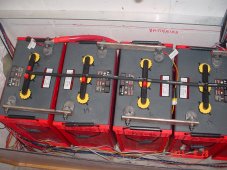I also used thick carboard templates . Then made a busbar template with the aluminum I used. In my case I was connecting vertical groups of 8 Nissan Leaf batteries so I needed 42 busbars about 11 inches long and 36 busbars about 7 inches long to connect the series connections at top bottom and middle of each 8 parallel cels . This adds up to over 714 inches of busbar or about 60 feet but I bought a few more feet than this side I wasted some ends though I bought 8 foot pieces of 1/8 by 1 inch aluminum flat stock. This ads up to 408 holes drilled just for the leaf cells. I also made square tubing connectors for Chevy Bolt batteries which would have been very difficult without drill press so I bought a cheap one at Harbor freight and it was well worth it. As you can imagine I didnt look forward to doing this by hand.It's nice to have the right tools! I was able to make do with what I had. If I could have taken it somewhere to have it done inexpensively I would have. These days that probably will never happen though. So, a hand drill, hand jigsaw, a strong table, big clamp, a piece of scrap 2x4 and some imagination get's her done!
I think to cardboard cutout templates was my best brainstorm though!
Each battery bank of about 20kwhr capacity only receives 1/4 of the charge of at max 212 amps but usually more like 160 amps so 40 amps per bank. each bank is connected by 2 guage welding cable to common busbars and then by short 2 guage cable to inverters. I havent yet but I plan to double the 48 series busbars. These cells are rated 250 amp continuous dc and double that intermittent load. I may in the future make each bank 4 parallell and about 10 Kwhr and the bolt batteries to 3 sets of 10 Kwhr . When I do that will make 7 sets of banks and each one will only receive max about 31 amps and usually less than 20 amps.
The aluminum is also much easier to work with and I used no ox.
I cut the busbars to length with a table saw using a worn blade and no problem but make sure and wear eye protection and leather gloves etc.







